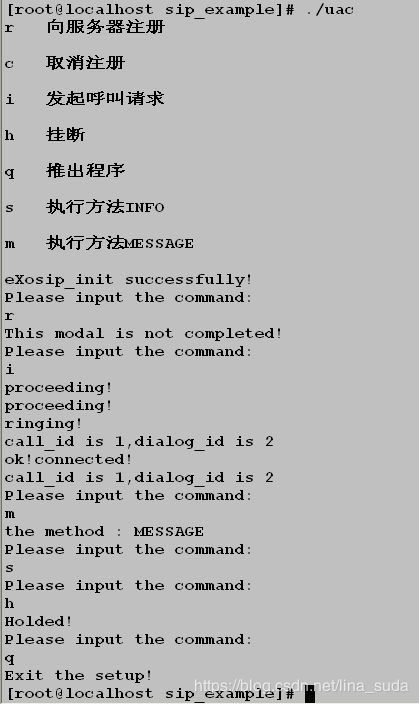linux下编译eXosip、osip,以及UAC和UAS的例子
从网站上看到了这样的一篇博文 :Windows下编译eXosip、osip,以及UAC和UAS的例子 (链接:http://www.cnblogs.com/dyllove98/archive/2013/06/25/3155427.html)
觉得对学习sip的初学者,包括我,都是很有帮助的。但是那是在window下的编译,我在这里稍微改了一下,让它支持在linux下编译测试运行通过。
我们这里使用库的版本:libosip2-3.6.0.tar,libeXosip2-3.6.0.tar,大家可以自己进入正面的链接去下载。
osip: http://ftp.twaren.net/Unix/NonGNU//osip/libosip2-3.6.0.tar.gz
eXosip: http://download.savannah.gnu.org/releases/exosip/libeXosip2-3.6.0.tar.gz
1、解压libosip2-3.6.0.tar ,比如解压目录为 /usr/local/src/,
#tar zxvf libosip2-3.6.0.tar -C /usr/local/src
编译该lib库:
#./configure
#make
#make install
2、同理编译libeXosip2
注意最后要更新库,否则在程序执行时,可能会提示找不到库,编译后的库文件及头文件会默认放在/usr/local目录下:
#ldconfig
3、编译代码uac.c 和 uas.c
#gcc uac.c -o uac -losip2 -leXosip2 -lpthread
#gcc uas.c -o uas -losip2 -leXosip2 -lpthread
4、测试运行uas 和 uac,最好打开两个shell来运行
#./uas
#./uac
注意:如果在运行过程中提示找不到libosip2.so.6等类似的提示,说明osip动态库的路径可能还没有包含进去,可以使用下面的命令手动包含动态库的路径
#export LD_LIBRARY_PATH=$LD_LIBRARY_PATH:/usr/local/lib
代码uac.c
#include
#include
#include
#include
#include
//#include
int main(int argc,char *argv[])
{
struct eXosip_t *context_eXosip;
eXosip_event_t *je;
osip_message_t *reg=NULL;
osip_message_t *invite=NULL;
osip_message_t *ack=NULL;
osip_message_t *info=NULL;
osip_message_t *message=NULL;
int call_id,dialog_id;
int i,flag;
int flag1=1;
char *identity="sip:[email protected]"; //UAC1,端口是15060
char *registar="sip:[email protected]:15061"; //UAS,端口是15061
char *source_call="sip:[email protected]";
char *dest_call="sip:[email protected]:15061";
//identify和register这一组地址是和source和destination地址相同的
//在这个例子中,uac和uas通信,则source就是自己的地址,而目的地址就是uac1的地址
char command;
char tmp[4096];
printf("r 向服务器注册\n\n");
printf("c 取消注册\n\n");
printf("i 发起呼叫请求\n\n");
printf("h 挂断\n\n");
printf("q 推出程序\n\n");
printf("s 执行方法INFO\n\n");
printf("m 执行方法MESSAGE\n\n");
//初始化
i=eXosip_init();
if(i!=0)
{
printf("Couldn't initialize eXosip!\n");
return -1;
}
else
{
printf("eXosip_init successfully!\n");
}
//绑定uac自己的端口15060,并进行端口监听
i=eXosip_listen_addr(IPPROTO_UDP,NULL,15060,AF_INET,0);
if(i!=0)
{
eXosip_quit();
fprintf(stderr,"Couldn't initialize transport layer!\n");
return -1;
}
flag=1;
while(flag)
{
//输入命令
printf("Please input the command:\n");
scanf("%c",&command);
getchar();
switch(command)
{
case 'r':
printf("This modal is not completed!\n");
break;
case 'i'://INVITE,发起呼叫请求
i=eXosip_call_build_initial_invite(&invite,dest_call,source_call,NULL,"This is a call for conversation");
if(i!=0)
{
printf("Initial INVITE failed!\n");
break;
}
//符合SDP格式,其中属性a是自定义格式,也就是说可以存放自己的信息,
//但是只能有两列,比如帐户信息
//但是经过测试,格式vot必不可少,原因未知,估计是协议栈在传输时需要检查的
snprintf(tmp,4096,
"v=0\r\n"
"o=anonymous 0 0 IN IP4 0.0.0.0\r\n"
"t=1 10\r\n"
"a=username:rainfish\r\n"
"a=password:123\r\n");
osip_message_set_body(invite,tmp,strlen(tmp));
osip_message_set_content_type(invite,"application/sdp");
eXosip_lock();
i=eXosip_call_send_initial_invite(invite); //invite SIP INVITE message to send
eXosip_unlock();
//发送了INVITE消息,等待应答
flag1=1;
while(flag1)
{
je=eXosip_event_wait(0,200); //Wait for an eXosip event
//(超时时间秒,超时时间毫秒)
if(je==NULL)
{
printf("No response or the time is over!\n");
break;
}
switch(je->type) //可能会到来的事件类型
{
case EXOSIP_CALL_INVITE: //收到一个INVITE请求
printf("a new invite received!\n");
break;
case EXOSIP_CALL_PROCEEDING: //收到100 trying消息,表示请求正在处理中
printf("proceeding!\n");
break;
case EXOSIP_CALL_RINGING: //收到180 Ringing应答,表示接收到INVITE请求的UAS正在向被叫用户振铃
printf("ringing!\n");
printf("call_id is %d,dialog_id is %d \n",je->cid,je->did);
break;
case EXOSIP_CALL_ANSWERED: //收到200 OK,表示请求已经被成功接受,用户应答
printf("ok!connected!\n");
call_id=je->cid;
dialog_id=je->did;
printf("call_id is %d,dialog_id is %d \n",je->cid,je->did);
//回送ack应答消息
eXosip_call_build_ack(je->did,&ack);
eXosip_call_send_ack(je->did,ack);
flag1=0; //推出While循环
break;
case EXOSIP_CALL_CLOSED: //a BYE was received for this call
printf("the other sid closed!\n");
break;
case EXOSIP_CALL_ACK: //ACK received for 200ok to INVITE
printf("ACK received!\n");
break;
default: //收到其他应答
printf("other response!\n");
break;
}
eXosip_event_free(je); //Free ressource in an eXosip event
}
break;
case 'h': //挂断
printf("Holded!\n");
eXosip_lock();
eXosip_call_terminate(call_id,dialog_id);
eXosip_unlock();
break;
case 'c':
printf("This modal is not commpleted!\n");
break;
case 's': //传输INFO方法
eXosip_call_build_info(dialog_id,&info);
snprintf(tmp,4096,"\nThis is a sip message(Method:INFO)");
osip_message_set_body(info,tmp,strlen(tmp));
//格式可以任意设定,text/plain代表文本信息;
osip_message_set_content_type(info,"text/plain");
eXosip_call_send_request(dialog_id,info);
break;
case 'm':
//传输MESSAGE方法,也就是即时消息,和INFO方法相比,我认为主要区别是:
//MESSAGE不用建立连接,直接传输信息,而INFO消息必须在建立INVITE的基础上传输
printf("the method : MESSAGE\n");
eXosip_message_build_request(&message,"MESSAGE",dest_call,source_call,NULL);
//内容,方法, to ,from ,route
snprintf(tmp,4096,"This is a sip message(Method:MESSAGE)");
osip_message_set_body(message,tmp,strlen(tmp));
//假设格式是xml
osip_message_set_content_type(message,"text/xml");
eXosip_message_send_request(message);
break;
case 'q':
eXosip_quit();
printf("Exit the setup!\n");
flag=0;
break;
}
}
return(0);
}
代码uas.c
# include
# include
# include
# include
# include
//# include
int main (int argc, char *argv[])
{
eXosip_event_t *je = NULL;
osip_message_t *ack = NULL;
osip_message_t *invite = NULL;
osip_message_t *answer = NULL;
sdp_message_t *remote_sdp = NULL;
int call_id, dialog_id;
int i,j;
int id;
char *sour_call = "sip:[email protected]";
char *dest_call = "sip:[email protected]:15060";//client ip
char command;
char tmp[4096];
char localip[128];
int pos = 0;
//初始化sip
i = eXosip_init ();
if (i != 0)
{
printf ("Can't initialize eXosip!\n");
return -1;
}
else
{
printf ("eXosip_init successfully!\n");
}
i = eXosip_listen_addr (IPPROTO_UDP, NULL, 15061, AF_INET, 0);
if (i != 0)
{
eXosip_quit ();
fprintf (stderr, "eXosip_listen_addr error!\nCouldn't initialize transport layer!\n");
}
for(;;)
{
//侦听是否有消息到来
je = eXosip_event_wait (0,50);
//协议栈带有此语句,具体作用未知
eXosip_lock ();
eXosip_default_action (je);
eXosip_automatic_refresh ();
eXosip_unlock ();
if (je == NULL)//没有接收到消息
continue;
// printf ("the cid is %s, did is %s/n", je->did, je->cid);
switch (je->type)
{
case EXOSIP_MESSAGE_NEW://新的消息到来
printf (" EXOSIP_MESSAGE_NEW!\n");
if (MSG_IS_MESSAGE (je->request))//如果接受到的消息类型是MESSAGE
{
{
osip_body_t *body;
osip_message_get_body (je->request, 0, &body);
printf ("I get the msg is: %s\n", body->body);
//printf ("the cid is %s, did is %s/n", je->did, je->cid);
}
//按照规则,需要回复OK信息
eXosip_message_build_answer (je->tid, 200,&answer);
eXosip_message_send_answer (je->tid, 200,answer);
}
break;
case EXOSIP_CALL_INVITE:
//得到接收到消息的具体信息
printf ("Received a INVITE msg from %s:%s, UserName is %s, password is %s\n",je->request->req_uri->host,
je->request->req_uri->port, je->request->req_uri->username, je->request->req_uri->password);
//得到消息体,认为该消息就是SDP格式.
remote_sdp = eXosip_get_remote_sdp (je->did);
call_id = je->cid;
dialog_id = je->did;
eXosip_lock ();
eXosip_call_send_answer (je->tid, 180, NULL);
i = eXosip_call_build_answer (je->tid, 200, &answer);
if (i != 0)
{
printf ("This request msg is invalid!Cann't response!\n");
eXosip_call_send_answer (je->tid, 400, NULL);
}
else
{
snprintf (tmp, 4096,
"v=0\r\n"
"o=anonymous 0 0 IN IP4 0.0.0.0\r\n"
"t=1 10\r\n"
"a=username:rainfish\r\n"
"a=password:123\r\n");
//设置回复的SDP消息体,下一步计划分析消息体
//没有分析消息体,直接回复原来的消息,这一块做的不好。
osip_message_set_body (answer, tmp, strlen(tmp));
osip_message_set_content_type (answer, "application/sdp");
eXosip_call_send_answer (je->tid, 200, answer);
printf ("send 200 over!\n");
}
eXosip_unlock ();
//显示出在sdp消息体中的attribute 的内容,里面计划存放我们的信息
printf ("the INFO is :\n");
while (!osip_list_eol ( &(remote_sdp->a_attributes), pos))
{
sdp_attribute_t *at;
at = (sdp_attribute_t *) osip_list_get ( &remote_sdp->a_attributes, pos);
printf ("%s : %s\n", at->a_att_field, at->a_att_value);//这里解释了为什么在SDP消息体中属性a里面存放必须是两列
pos ++;
}
break;
case EXOSIP_CALL_ACK:
printf ("ACK recieved!\n");
// printf ("the cid is %s, did is %s/n", je->did, je->cid);
break;
case EXOSIP_CALL_CLOSED:
printf ("the remote hold the session!\n");
// eXosip_call_build_ack(dialog_id, &ack);
//eXosip_call_send_ack(dialog_id, ack);
i = eXosip_call_build_answer (je->tid, 200, &answer);
if (i != 0)
{
printf ("This request msg is invalid!Cann't response!\n");
eXosip_call_send_answer (je->tid, 400, NULL);
}
else
{
eXosip_call_send_answer (je->tid, 200, answer);
printf ("bye send 200 over!\n");
}
break;
case EXOSIP_CALL_MESSAGE_NEW://至于该类型和EXOSIP_MESSAGE_NEW的区别,源代码这么解释的
/*
// request related events within calls (except INVITE)
EXOSIP_CALL_MESSAGE_NEW, < announce new incoming request.
// response received for request outside calls
EXOSIP_MESSAGE_NEW, < announce new incoming request.
我也不是很明白,理解是:EXOSIP_CALL_MESSAGE_NEW是一个呼叫中的新的消息到来,比如ring trying都算,所以在接受到后必须判断
该消息类型,EXOSIP_MESSAGE_NEW而是表示不是呼叫内的消息到来。
该解释有不妥地方,仅供参考。
*/
printf(" EXOSIP_CALL_MESSAGE_NEW\n");
if (MSG_IS_INFO(je->request) ) //如果传输的是INFO方法
{
eXosip_lock ();
i = eXosip_call_build_answer (je->tid, 200, &answer);
if (i == 0)
{
eXosip_call_send_answer (je->tid, 200, answer);
}
eXosip_unlock ();
{
osip_body_t *body;
osip_message_get_body (je->request, 0, &body);
printf ("the body is %s\n", body->body);
}
}
break;
default:
printf ("Could not parse the msg!\n");
}
}
} 运行截图:
usc.c结果:

